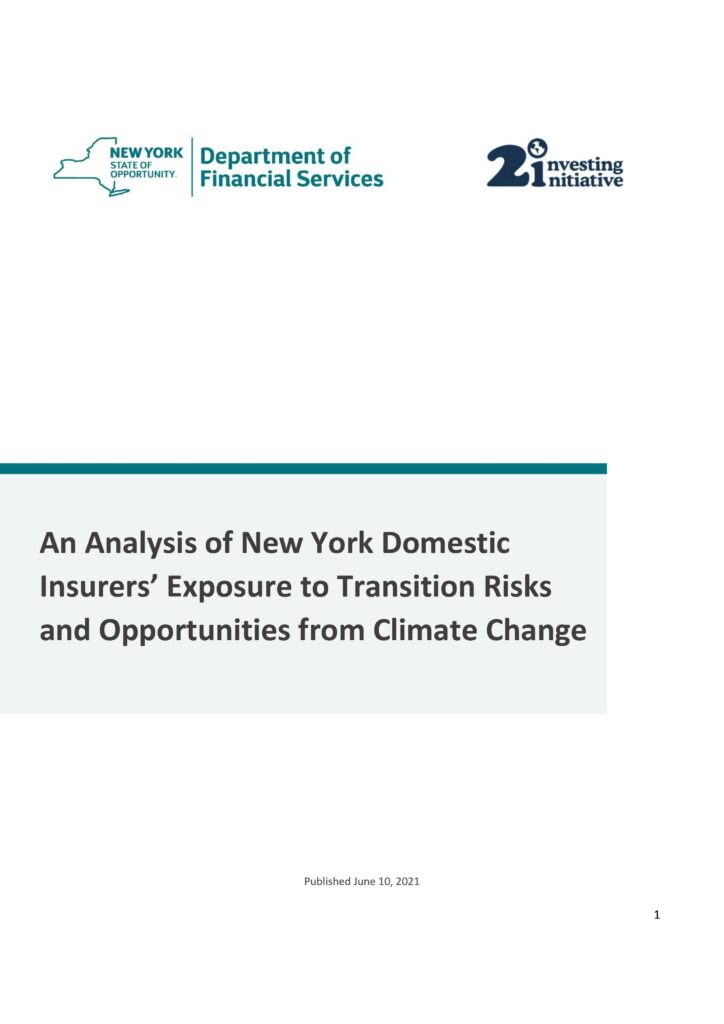The study is among the first by a US supervisor to measure the industry’s exposure to climate-related financial risks, following 2DII’s collaboration with the California Department of Insurance. The report comes as financial supervisors around the globe are increasingly scrutinizing their regulated entities’ exposure to climate-related financial risks and strategies for mitigating them. DFS is the second US regulator that 2DII has supported in this type of study, following collaborations with the California Department of Insurance. 2DII has also worked with numerous international supervisors, including the European Insurance & Occupational Pensions Authority (EIOPA), the Bank of England, the Dutch Central Bank and the Japanese Financial Services Agency.
DFS, the largest state financial supervisor in the country, supervises and regulates the activities of nearly 1,800 insurance companies with assets of more than $4.7 trillion and approximately 1,500 banking and other financial institutions with assets totaling more than $2.6 trillion. 2DII’s analysis covered 250 insurance companies with portfolios worth more than $550 billion. This report furthers DFS’s efforts to support New York insurers in managing the financial risks from climate change.
2DII analyzed the transition risks of New York domestic insurers by assessing the alignment of their equity and corporate bond portfolios using their 2019 Schedule D data against different climate scenarios. The exposure and scenario analysis used in 2DII’s analysis is based on the open-source Paris Agreement Capital Transition Assessment (PACTA) model, which has been used by more than 3,000 financial institutions, governments, supervisory authorities, and industry associations.
The report’s findings include:
- New York domestic insurers’ investments had meaningful exposure to carbon intensive sectors. The U.S. recently rejoined the Paris Agreement, which seeks to keep global temperature rise in this century to well below 2°C above pre-industrial levels. The five-year forward-looking capital plans of most companies in these sectors in which insurers had invested were not aligned with the Paris Agreement, with the exception of natural gas production, natural gas-fired power generation, and electric vehicle production. In many cases, insurers’ portfolios were less Paris-aligned than market benchmarks.
- Life insurers generally had greater exposure to carbon intensive sectors than P&C and health insurers. Exposure to high-carbon technologies also varied dramatically among individual insurers. While most insurers had single-digit exposures to the fossil fuel sector as a percentage of their corporate bond and equity portfolios, several P&C insurers and a few life insurers had exposures that were significantly higher. When insurers underinvest in low-carbon technologies, they are exposed to greater transition risks and miss out on many of the opportunities that arise from the low-carbon transition.
In addition, the report outlines investment-related strategies that insurers can consider to mitigate their transition risk exposure, including divestment, investment, exclusion, engagement, and setting climate-related investment conditions. As stated in DFS’s proposed Guidance for New York Domestic Insurers on Managing the Financial Risks from Climate Change, DFS is focused on the financial stability of insurers in the face of climate change. While insurers are expected to understand and manage their exposure to climate-related financial risks, DFS does not dictate insurers’ investment activities. In addition, each insurer should take a proportionate approach to managing these risks that reflects its unique exposure and the nature, scale, and complexity of its business.
Helping insurers move beyond alignment
To help insurers assess and develop strategies to mitigate their exposure to transition risks, DFS also requested that 2DII generate individual reports for insurers included in 2DII’s analysis, which will be shared with such insurers. Insurers not included in 2DII’s analysis can use the open-source PACTA model and upload their equity and bond positions to create their own reports.
2DII’s Impact Program has developed tools to help insurers and other financial institutions go deeper, by devising climate strategies to contribute to Paris Agreement objectives. Once financial institutions understand their exposure to climate-related risks, they can then use these tools to take the next step: developing climate strategies that are backed by scientific evidence and formulated to help reduce greenhouse-gas emissions in the real economy.
These tools include the Climate Impact Management System, which provides financial institutions with a clear roadmap to develop, refine, and communicate on impactful climate strategies, as well as a Climate Action Guide, an interactive tool detailing actions that financial institutions can take to contribute to emissions reductions in the real world. The guide is searchable by type of institution, asset of interest, and action, and maps each action to various ‘levels of evidence.’
Funder information: This work was made possible in part by a grant from the ClimateWorks Foundation, which supports 2DII’s work with supervisors. This work reflects the authors’ opinions alone, and the funder is not responsible for any use that may be made of the information it contains.






